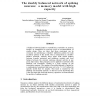Free Online Productivity Tools
i2Speak
i2Symbol
i2OCR
iTex2Img
iWeb2Print
iWeb2Shot
i2Type
iPdf2Split
iPdf2Merge
i2Bopomofo
i2Arabic
i2Style
i2Image
i2PDF
iLatex2Rtf
Sci2ools
NIPS
2003
2003
The Doubly Balanced Network of Spiking Neurons: A Memory Model with High Capacity
A balanced network leads to contradictory constraints on memory models, as exemplified in previous work on accommodation of synfire chains. Here we show that these constraints can be overcome by introducing a 'shadow' inhibitory pattern for each excitatory pattern of the model. This is interpreted as a doublebalance principle, whereby there exists both global balance between average excitatory and inhibitory currents and local balance between the currents carrying coherent activity at any given time frame. This principle can be applied to networks with Hebbian cell assemblies, leading to a high capacity of the associative memory. The number of possible patterns is limited by a combinatorial constraint that turns out to be P=0.06N within the specific model that we employ. This limit is reached by the Hebbian cell assembly network. To the best of our knowledge this is the first time that such high memory capacities are demonstrated for models of spiking neurons.
| Added | 31 Oct 2010 |
| Updated | 31 Oct 2010 |
| Type | Conference |
| Year | 2003 |
| Where | NIPS |
| Authors | Yuval Aviel, David Horn, Moshe Abeles |
Comments (0)

